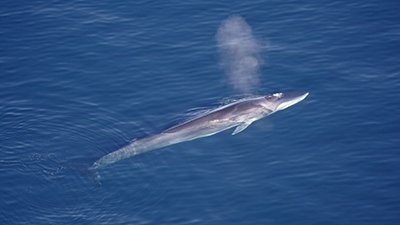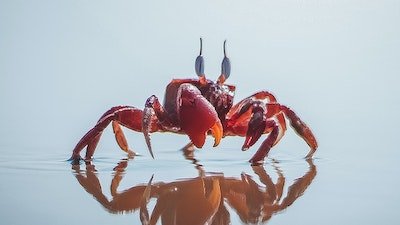
Blue Whale: The Mammoth of the Sea
Life as a Blue Whale
What is the largest animal of all time—even larger than the most massive dinosaurs? The answer is the blue whale. These giants average about 70 feet in length, although some were reportedly more than 100 feet long during the whaling era. That’s about the length of three school buses! While some dinosaurs were longer from nose to tail, the blue whale still tops them in sheer bulk. Blues weigh around 200,000 pounds (100 tons), while the largest land mammal today is the African bull elephant, which may weigh eight tons. If the blue whale lived on land, its skeleton would collapse under its weight.1 But the blue whale’s home is the vast ocean expanse, where the water’s buoyant force supports its bulk.
Since whales are air-breathing mammals, humans may encounter the enormous blue when it surfaces to breathe through the two blowholes on its back. It breathes out an impressive spout that shoots an air and water spray 20 to 30 feet high. Between dives, the blue whale may surface for air every 10 to 30 minutes.
In the water, the blue whale’s long, streamlined body swims efficiently at speeds of up to 30 miles per hour. In comparison, humans can only swim up to four or five miles per hour. The speed and size of the blue whale helps it cruise the hundreds of miles between patches of food. Along the way, the whale is sustained by its substantial fat stores, called blubber.
The primary food source of the mammoth blue whale is tiny, shrimp-like krill. The blue whale lunges to gulp swimming pool quantities of water, expanding the bottom pleats of its mouth—the ventral pouch—like a giant water balloon. When lunging, the water forces the lower jaw to open nearly 90 degrees. Scientists wondered how the whale could manage to close its jaw against the force of the water until they discovered a structure called the frontomandibular stay that causes resistance and helps the jaw snap shut.
Once the whale has its mouth shut around thousands of gallons of seawater, it strains out the water through its baleen. Baleen is made of keratin, the same substance that helps make up people’s fingernails and hair. It hangs in tough, bristled plates, ranging from one and a half feet in the back sides of the mouth to three feet up front. The water flows out, but the baleen traps the krill. During the peak summer season, the whale may encircle a krill patch, swallowing about 40 million krill or four tons of food a day.
Blues communicate to one another at sounds often too low for humans to hear without equipment. Yet the sound is one of the loudest of any in the animal kingdom.2 Researchers have yet to find out how such vocalizations are made, since they have not found any sound-making organ or resonating structure.3 Much remains to be discovered about the colossal blue whale.

Snapshot
- Blue whales are not all blue. Although the head is usually a blue color, the back is more of a mottled blue-gray. The underside is a lighter, whitish color.
- At birth, a blue whale calf may weigh 6,000 pounds and measure 25 feet long.
- Blues are thought to live around 70 years.
- Each year, most blues migrate, swimming thousands of miles by an unknown compass. While migrating, they fast from food for four months or more, surviving on fat stores.
Divine Design
If you consult many science textbooks, you’ll read a whale of a tale about how whales supposedly evolved. Evolutionists believe some land animals—perhaps in search of a better source of food—returned to the sea as air-breathing marine mammals like blue whales.
Despite claims that the fossil record shows the missing links between land mammals and marine mammals, the transitional forms are far from convincing or complete. Rather, whales appear in the fossil record abruptly with all the complex systems in place to thrive in the sea. Transitional forms provide no evidence for how the whale “evolved” complex systems like the ear designed for underwater hearing and pressure, tail that moves vertically, blubber and countercurrent heat exchangers to keep warm,4 respiratory system able to withstand high pressure and long periods underwater, and the ability to birth and nurse underwater. Furthermore, baleen whales like blues are the only animals known to strain their food with baleen.
Complex structures like baleen cannot form by random mutation. Natural selection is also inadequate because adaptation involves a change of traits that already exist. Therefore, change happens only within a kind—not a change from one kind to another, like a land animal to a whale.
In contrast to the evolutionary assumption of land mammals evolving into marine mammals, the biblical account says sea creatures like whales were created on Day Five of Creation Week (Genesis 1:20–23), a whole day before the land animals were created. Whales display divine design.
O Lord, how manifold are your works!
In wisdom you have made them all;
the earth is full of your creatures.Here is the sea, great and wide,
which teams with creatures innumerable,
living things both small and great. (Psalm 104:24–25; cf. Psalm 148:7).
Further Reading
- Another Whale of a Tale: Creationists Without a “Whimper”?
- Walking Whales, Nested Hierarchies, and Chimeras: Do They Exist?
- The World of Whales
- Scientific Roadblocks to Whale Evolution (Institute for Creation Research)
- No Time for Bone-eating Worm to Evolve (Institute for Creation Research)
Creation Corner
Remember that everything was cursed because of man's sin (think specifically of the ground and serpent mentioned in Genesis 3). Death then intruded upon God’s perfect creation, so animals, people, and plants have had to fight for survival ever since. Because of the Curse, traits developed that would have been unnecessary before Adam sinned, like venom and stingers for attack and defense. Keep in mind, though, that not all deadly looking features necessarily had to develop! Fruit bats are a great example of how mean-looking teeth can work just as well for ripping apart vegetation, not flesh! For more about how and why deadly structures are now a part of our world, see “How Did Defense/Attack Structures Come About?”
Of course some animals are impressive for their beauty and design, too. Seeing things through the lens of Scripture, we see an all-wise and intelligent God who spoke animals into existence in a perfect world that was soon marred by sin and death. We can praise the Creator for a remnant of that incredible beauty and design still. And God has also thus provided us with examples of his intelligence and provision that we can put to good use in biomimicry. Join us in giving glory to God for his loving care for us and his creation, despite the curse.
– Editor
Footnotes
- “Blue Whale: Balaenoptera musculus,” American Cetacean Society, accessed June 22, 2017, http://acsonline.org/fact-sheets/blue-whale-2/.
- Ella Davies, “The World’s Loudest Animal Might Surprise You,” BBC, April 1, 2016, http://www.bbc.com/earth/story/20160331-the-worlds-loudest-animal-might-surprise-you.
- Dan Bortolotti, Wild Blue: A Natural History of the World’s Largest Animal (New York: St. Martin’s Press, 2008), 164.
- Frank Sherwin, “Running Counter to Evolution,” Acts & Facts 33, no. 9 (2004), http://www.icr.org/article/running-counter-evolution/.
Recommended Resources

Answers in Genesis is an apologetics ministry, dedicated to helping Christians defend their faith and proclaim the good news of Jesus Christ.
- Customer Service 800.778.3390
- © 2024 Answers in Genesis




